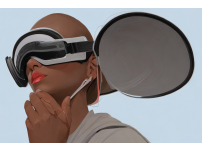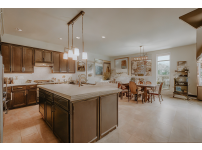조경 업계의 가상 현실(VR): 정원 설계 및 계획 개선(Virtual Reality in the Landscaping Ind…
본문
가상현실(VR) 기술은 다양한 산업에서 상당한 발전을 이루어 왔으며 조경 산업도 예외가 아니다. VR은 정원과 풍경을 설계하고 계획하는 방식에 혁명을 일으킬 수 있는 잠재력을 가지고 있으며, 고객과 조경 전문가 모두에게 혜택을 제공합니다.
조경 업계에서 VR의 가장 큰 장점 중 하나는 시각화 개선입니다. VR을 통해 고객은 공사가 시작되기 전에 정원의 가상 표현을 경험할 수 있으며, 이를 통해 실시간으로 설계를 변경하고 수정할 수 있습니다. 이것은 오해를 없애는 데 도움이 되고 최종 제품이 고객의 기대에 부합하도록 보장합니다.
게다가, VR 기술은 또한 설계 과정을 개선하는 데 사용될 수 있습니다. 조경 전문가들은 VR 도구를 사용하여 태양 노출, 바람 패턴, 토양 조건과 같은 다양한 요소를 시뮬레이션하여 특정 위치에 가장 적합한 설계를 결정할 수 있습니다. 이를 통해 보다 효과적이고 매력적인 정원 설계가 가능할 뿐만 아니라 선택된 식물과 나무가 위치에 적합하도록 하여 고장 위험을 줄일 수 있습니다.
한국에서, 조경 산업에서 VR의 주목할 만한 예는 서울에 본사를 둔 회사인 서울 풍경입니다. 이 회사는 디자인 과정에 VR 기술을 구현하여 고객이 정원의 가상 표현을 경험할 수 있도록 하고 디자인을 시각화하고 이해하기 쉽게 만들었습니다.
결론적으로, VR 기술은 개선된 시각화, 더 나은 디자인, 더 효과적이고 즐거운 정원 계획 과정과 같은 이점을 제공함으로써 조경 산업을 크게 향상시킬 수 있는 잠재력을 가지고 있습니다. VR 기술이 계속 발전함에 따라, 우리는 더 많은 조경 전문가들이 VR 도구를 사용하여 고객의 요구와 욕구를 충족시키는 혁신적이고 효과적인 정원 디자인을 만드는 것을 기대할 수 있습니다.
요약하자면, 조경 산업에서 가상 현실을 사용하는 것은 개선된 시각화, 설계 및 전체적인 정원 계획 경험을 포함하여 많은 이점을 제공합니다. 조경에 VR 기술이 적용됨에 따라 전문가들은 보다 정확하고 효과적이며 즐거운 정원을 만들 수 있으며, 산업을 더욱 발전시키고 모든 사람들을 위한 야외 환경을 개선할 수 있습니다.
가상 현실은 디자이너와 고객이 이전에는 불가능했던 방식으로 정원 디자인을 시각화하고 계획할 수 있도록 함으로써 조경 산업에 혁명을 일으킬 수 있는 잠재력을 가지고 있습니다. VR 기술을 통해 이제 정원 디자인의 3D 모델을 만들고 다양한 조명과 날씨 조건을 시뮬레이션하여 완성된 제품을 보다 사실적이고 정확하게 표현할 수 있습니다.
한국에서, 삼성과 LG와 같은 회사들은 이미 그들의 정원 디자인 소프트웨어에 VR 기술을 구현했습니다. 삼성의 "경관 디자인 스튜디오"는 사용자들이 가상의 정원 디자인을 만들기 위해 다양한 식물, 나무, 그리고 다른 요소들을 선택하고 배열할 수 있게 합니다. 이 소프트웨어에는 각 요소의 크기와 위치를 조정하는 도구뿐만 아니라 비와 눈과 같은 다양한 기상 조건을 시뮬레이션하는 도구도 포함되어 있습니다.
또 다른 예로는 LG의 "가든 디자이너 VR" 소프트웨어가 있는데, 이 소프트웨어는 VR 기술을 사용하여 사용자들에게 더욱 몰입적이고 상호작용적인 경험을 제공합니다. 이 소프트웨어를 사용하면 사용자는 가상 정원 설계를 통해 정원이 완성되면 어떻게 보이고 느낄지 더 잘 이해할 수 있습니다. 이 소프트웨어는 자신의 비전과 선호도에 완벽하게 맞는 정원을 만들고자 하는 고객에게 특히 유용합니다.
결론적으로 조경산업에서의 가상현실 활용은 아직 초기 단계이지만 이미 유망한 성과를 보이고 있습니다. VR 기술은 고객에게 정원 디자인을 보다 정확하고 사실적으로 표현할 수 있는 기능을 제공함으로써 조경 산업의 계획 및 설계 프로세스를 크게 개선할 수 있는 잠재력을 가지고 있습니다. VR 기술이 계속 발전하고 개선됨에 따라, 우리는 가까운 미래에 조경 산업에서 VR 기술의 채택이 증가할 것으로 예상됩니다.
Virtual Reality (VR) technology has been making significant advancements in various industries, and the landscaping industry is no exception. VR has the potential to revolutionize the way we design and plan gardens and landscapes, offering benefits for both clients and landscaping professionals.
One of the biggest advantages of VR in the landscaping industry is improved visualization. With VR, clients can experience a virtual representation of their garden before construction begins, allowing them to make changes and modifications to the design in real-time. This helps to eliminate any misunderstandings and ensures that the final product meets the client's expectations.
Moreover, VR technology can also be used to improve the design process. Landscaping professionals can use VR tools to simulate various elements such as sun exposure, wind patterns, and soil conditions to determine the best design for a particular location. This not only results in a more effective and attractive garden design but also helps to ensure that the plants and trees selected are suitable for the location, reducing the risk of failure.
In Korea, a notable example of VR in the landscaping industry is the Seoul-based company, Seoul Landscape. The company has implemented VR technology in its design process, allowing clients to experience a virtual representation of their garden and making it easier to visualize and understand the design.
In conclusion, VR technology has the potential to greatly enhance the landscaping industry, offering benefits such as improved visualization, better design, and a more effective and enjoyable garden planning process. As VR technology continues to advance, we can expect to see more landscaping professionals utilizing VR tools to create innovative and effective garden designs that meet the needs and desires of their clients.
In summary, the use of virtual reality in the landscaping industry offers many advantages, including improved visualization, design, and overall garden planning experience for clients. With the implementation of VR technology in landscaping, professionals can create more accurate, effective, and enjoyable gardens, further advancing the industry and improving the outdoor environment for everyone.
Virtual reality has the potential to revolutionize the landscaping industry by allowing designers and clients to visualize and plan garden designs in a way that was previously impossible. With VR technology, it is now possible to create 3D models of garden designs and simulate different lighting and weather conditions to give a more realistic and accurate representation of the finished product.
In Korea, companies such as Samsung and LG have already implemented VR technology in their garden design software. Samsung's "Landscape Design Studio" allows users to select and arrange different plants, trees, and other elements to create a virtual garden design. The software also includes tools for adjusting the size and location of each element, as well as tools for simulating different weather conditions, such as rain and snow.
Another example is LG's "Garden Designer VR" software, which uses VR technology to provide a more immersive and interactive experience for users. With this software, users can walk through their virtual garden designs and get a better understanding of how their garden will look and feel once completed. This software is especially useful for clients who are looking to create a garden that perfectly matches their vision and preferences.
In conclusion, the use of virtual reality in the landscaping industry is still in its early stages but has already shown promising results. With the ability to provide clients with more accurate and realistic representations of garden designs, VR technology has the potential to greatly improve the planning and design process in the landscaping industry. As VR technology continues to evolve and improve, it is likely that we will see an increased adoption of VR technology in the landscaping industry in the near future.














댓글목록 0